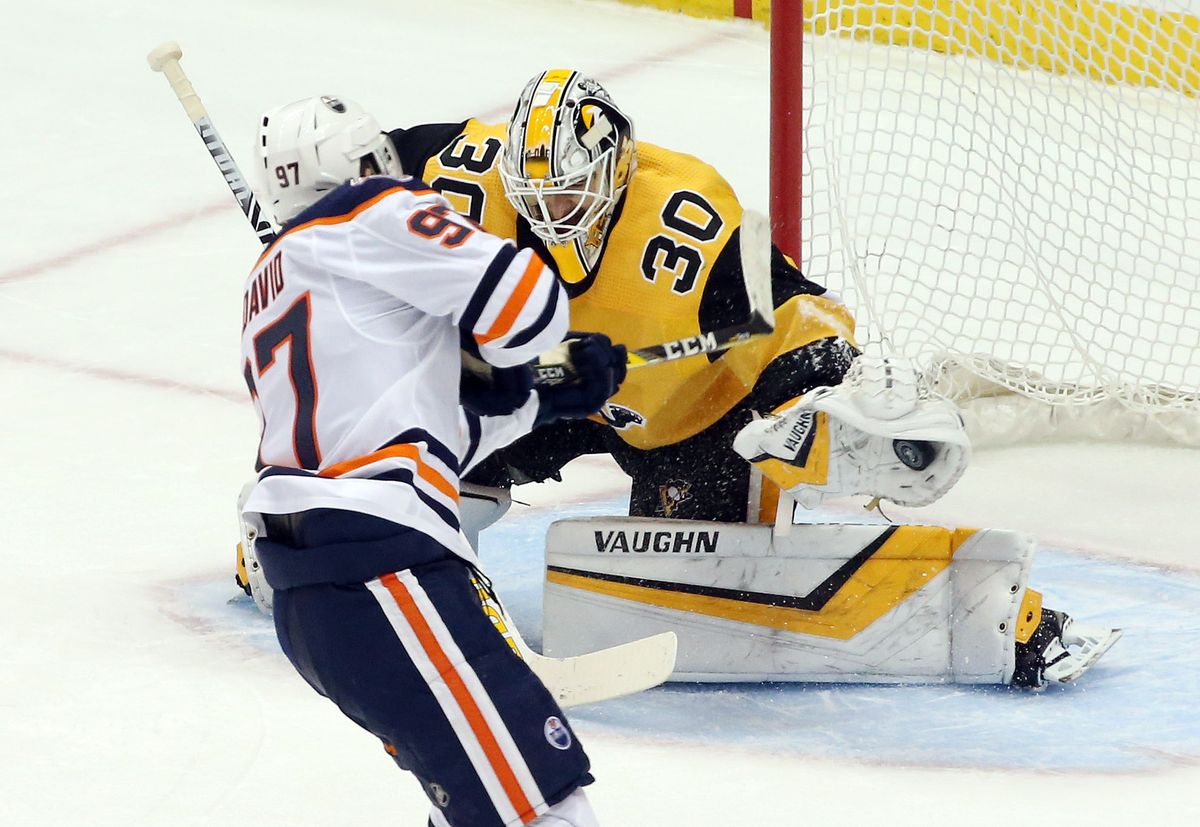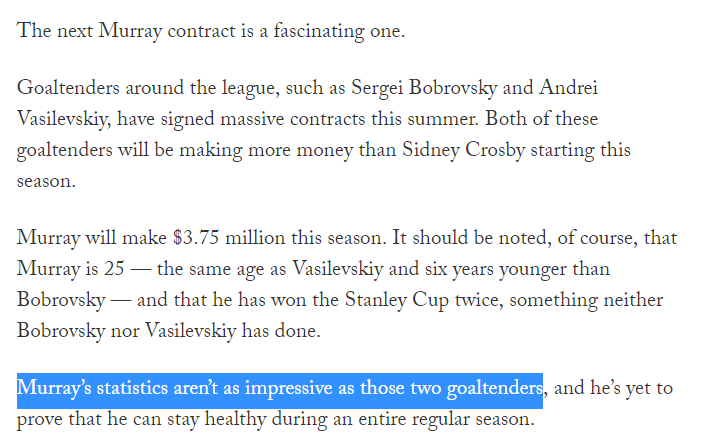
CHARLES LECLAIRE/USA TODAY SPORTS VIA REUTERS
The Penguins offseason was filled with tumultuous storylines.
Whether it was signing Brandon Tanev to a hefty contract, trading away Olli Maatta, trying to trade Phil Kessel, eventually trading Phil Kessel, having absolutely no cap space and Jack Johnson remaining a Pittsburgh Penguin, one person that flew under the radar this summer was Matt Murray.
That’s not a bad thing.
His name has come up periodically when GMJR talks to the local beat writers in the context of Murray’s next contract. The 25 year old, two-time Cup winning netminder is a restricted free agent at the conclusion of this season when his 3 year deal at $3.75M per year comes to an end. He’ll be arbitration eligible, but it’s hard to imagine a world where the Penguins let it come to that.
Still, there’s a lot of uncertainty around what his next contract may look like, particularly after Andrei Vasilevskiy’s monster 8 year, $9.5M per deal that was signed in July, which kicks in at the start of the 2020-21 season (same as Murray’s next deal). You’ll also recall Vasilevskiy signing a similar 3 year, $3.5M per year deal nearly 4 months prior to Murray’s extension.
Conventional wisdom will tell you, based upon his age and resume to date, he’ll see his next contract come in right around Tuukka Rask/Braden Holtby/John Gibson/Connor Hellebuyck in both term and money more so than that of Vasilevskiy.
Looking at those, you’d be hard-pressed to believe that sort of money and term for a 2 time Stanley Cup Champion goaltender doesn’t just feel right.
In the cases of Rask and Holtby, both contracts immediately looked like steals as both netminders went on to win the Vezina in their first year under their current contracts. For Rask in particular, his deal came on the heels of sweeping the Penguins, but falling in the Stanley Cup Final in 2013.
In the cases of Hellebuyck and Gibson last summer, the contracts locked them up following a season in which Hellebuyck, at 25, finished 2nd in Vezina voting and Gibson, inexplicably snubbed, finished with 31 wins, 4 shutouts, and a .926 SV%.
You’ll notice a trend here: the Vezina trophy, an award Matt Murray has not won yet in his fledgling career.
You can make the case that winning back-to-back Stanley Cups as a rookie goaltender is far more impressive of a feat, but we’ll save value-rated nuanced discussion for a different day.
Which brings us back to the Penguins, Matt Murray, and Jim Rutherford, who made it clear to Josh Yohe of The Athletic: “Just because other goaltenders around the league are receiving massive new contracts doesn’t mean the Penguins are in a rush to sign Matt Murray to a new deal.”
This is a stark difference from other quotes from Rutherford suggesting that he wanted/expected to get Murray inked to a new contract prior to training camp. That, though, is hardly the issue.
The issue falls on the reluctance to categorize Matt Murray as one of the top netminders in the league:
It should be noted that $9M+ for a goaltender is outrageous and much of this is likely posturing from Rutherford, particularly after seeing Vasilevskiy’s contract, in an effort to quell Murray and his agent’s ask of something comparable. These quotes came in the immediate aftermath of those deals being signed, after all.
But when discussing Murray’s worth, the talking points always circle back to the (lazy) narrative of “he’s injury-prone” or “his glove hand is awful.”
Without discussing the first bit of that, let’s talk about that glove hand for a moment.
I went back and looked at all 141 goals that were scored against Murray last season, including the playoffs, and tracked the location where he was beaten.
And as it turns out, he wasn’t beaten on his glove side any more than any other location.
https://twitter.com/G_Off817/status/1172601430093512704
Some things to note about this information. First, this is extremely raw, preliminary info. I haven’t tracked every goal against every goaltender to establish league-wide average in each location (though, I will be doing that this season). I also haven’t done the nearly impossible task of tracking each shot at each location to establish a SV% for those spots.
There is also some nuance surrounding these numbers. Notably, there were some goals captured in this that end up in a certain location that don’t totally reflect the play itself or account for deflections, tips, or plays where he was moved side to side and the puck was put into the empty net behind him.
This is the nature of the beast in playing a position that has a lot of noise and randomness inherent in it, but some examples include this one that went in off Patric Hornqvist’s body:
https://gfycat.com/oddballediblehartebeest-shg
Or this wild deflection that counts as a “high glove” goal against:
[protected-iframe id=”89bbbf3bd43401dd1e73d8fa5cd8fead-142507471-50437453″ info=”https://www.nhl.com/video/embed/borgstroms-shot-deflects-in/t-300082278/c-66587103?autostart=false” width=”540″ height=”360″]Or these two goals that pop up on the glove side.
[protected-iframe id=”82eb6b998b780f3657e21ab3d7c0178c-142507471-65641076″ info=”https://www.nhl.com/video/embed/seguin-buries-radulovs-nice-feed/t-300085718/c-67159503?autostart=false” width=”540″ height=”360″]https://twitter.com/G_Off817/status/1113229196631990272
The point remains that Matt Murray didn’t give up goals on the glove side any more than any other location. In fact, the distribution is pretty consistent all around.
The other point that remains is that from a statistical standpoint, Matt Murray stacks up fairly well against his fellow goaltender union members and, in the case of last season, was something special as the season wore on.
That’s not to say that Murray’s season wasn’t every bit of that cliche rollercoaster.
It was.
Prior to going down with an injury in November, his play was suspect at best. He struggled to make saves all while the Penguins refused to defend in front of him, hitting a season low point in November that wasn’t anywhere close to being replicated the rest of the way.
But the contrast in the 11 games prior to his injury and the 8 games after was stark. By the time mid-February rolled around, he found himself in the upper echelon of most categories in that 2 month stretch from December 15th to February 14th.
Heading into the postseason, we had this to say:
What’s more is that in spite of that rough start, Murray found himself in the top 10 this season in overall SV% among goaltenders that played 25+ games, having never really looked back after returning from injury in December. In fact, since December 15th, his .930 overall save percentage ranks 5th among 42 goalies that played 20+ games (with Lehner’s .937 and Greiss’ .933 ranking 2nd and 3rd) and his .943 SV% at 5v5 over that same period was the 3rd best among 65 goalies that played 300+ minutes (Greiss – .945 ranked 2nd and Lehner’s .941 ranked 5th among that set).
…
There were obviously some roadbumps along the way, but he hasn’t really looked back since March 1st either as the postseason began approaching and HCMS started to rely on him much, much more. In fact, Murray was called upon to start in 20 of the remaining 21 games, including the final 11. The result: an 11-4-5 record where he recorded the 2nd most wins, a .928 SV% at all strengths and a .950 SV% at 5v5.
On top of that, via Corsica, his expected save percentage for the season among goalies that played 800 minutes of 5v5 time of 92.45% ranked 8th best (out of 61 goaltenders), while his raw count of goals saved above average (11) was 7th best out of that same pool.
| Category | Murray | Rank |
| Save Percentage | .933 | 8th |
| Expected Save Percentage | .925 | 9th |
| High Danger Save Percentage | .839 | 8th |
| Goals Saved Above Average | 11 | 7th |
For the sake of comparison, Vasilevskiy ranked 12th (.929), 2nd (.929), 52nd (.770), and 26th (0.98) respectively in each of those above categories.
But, perhaps more importantly, for Matt Murray to find himself in the top 10 of all of those after the start that he had speaks volumes to his play from December onward last year.
As you might expect, not a whole lot changes when looking at Murray’s rank among the 60 goaltenders that played at least 1000 minutes in all situations last year, too.
| Category | Murray | Rank |
| Save Percentage | .919 | 11th |
| Expected Save Percentage | .914 | 13th |
| High Danger Save Percentage | .795 | 31st |
| Goals Saved Above Average | 7.44 | 16th |
Comparing that again to Vasilevskiy, who ranked 6th (.925), 2nd (.919), 26th (.801), and 10th (10.64), and you start to get the sense that maybe Murray wasn’t that far off from the Vezina winner, despite seeing more quality against.
Now, where Murray and the Penguins can (and need to) improve is on special teams.
This is where Murr performed below expectation, registering an expected save percentage of 87.75%, but an actual SV% of 85.16% on the penalty kill and an 89.96% expected vs. 85.71% actual on the powerplay.
Compare that to Vasilevskiy’s 88.56% expected vs. 91.01% actual (with 6.54 goals saved above average) shorthanded and 90.72% expected vs. 98.11% actual.
What should also be considered here is how loose the Penguins were with the puck on the powerplay last year. You’ll recall that they led the league (with the Bruins) in shorthanded goals against with 15.
It should come as no surprise that Tuukka Rask (3rd – 11.02//1st – 8.5), Jaroslav Halak (2nd – 11.54//2nd – 6.98), and Matt Murray (9th – 9.53//9th – 5.15) faced more scoring chances and high danger scoring chances against per 60 minutes of powerplay time than most goaltenders in the league (per Natural Stat Trick).
It’s hard to imagine a world where the Penguins and Murray are victimized again like that this year. And if they’re not, you should see Murray rank even higher across the board with respect to the rest of the league in all situations.
All that is to say that Murray is going to be due a significant pay raise sometime over the next 365 days. If the Penguins tighten things up defensively in front of Matt Murray this season as he continues to grow and evolve his game behind them, you can reasonably expect his raise to increase more and more as the months go by.
And having a top 10 goaltender to rely upon in net is never a bad thing.
Add The Sports Daily to your Google News Feed!



